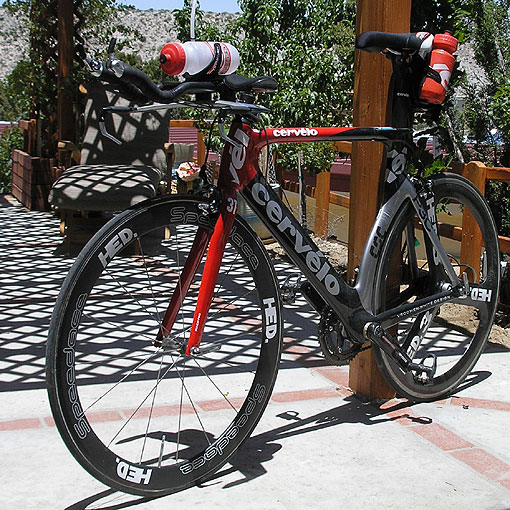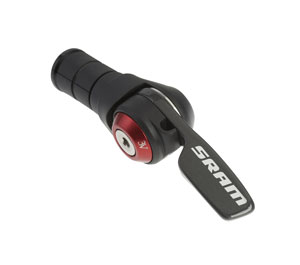Preferred build: Kuota’s new Kueen K
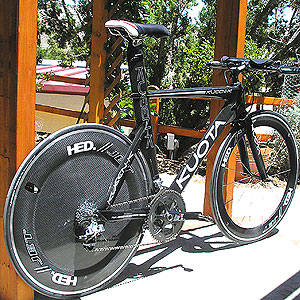
In broad strokes there are two types of tri bikes out there: those long and low; and those short and tall. By long and low I mean the bikes have a lot of reach and not much stack, and by that I mean that the front of the bike, and specifically the head tube, is pushed well out in front of the bottom bracket, with the top of the head tube sitting lower to the ground. This allows those of us who ride with a lot of "drop" to get our bars low enough to the ground. Cervelos, Felts, Kestrel Airfoil Pros, are all examples of long, low tri bikes.
The Kueen K is another in that category and, in a departure from the norm, Kuota's tri bikes do not follow a consistent brand-wide theme. Kuota's K-Factor is closer to the short and tall style, and the Kalibur is in between.
The Kueen K is more my cup of tea, because I ride my tri bike steep, and pushing the saddle forward pushes the head tube further in front of the crank (making it necessary for my bike to be long). Riding steep means I can ride with more drop, and for this reason I need the bike to be low. The Kueen K accommodates this, with a geometry quite similar to the Cervelo P3C, the bike I raced several times over the last weeks and the subject of the Preferred Build column last month. Geometrically, then, the Kueen K works for me. As we will see, however, the bike is not an automatic match for me, as it is built and presented here, for reasons I will explain.
I chose to build the Kueen K with SRAM's Red Group, which Jay Prasuhn wrote about on Slowtwitch earlier this Summer, and we mounted up Valdora Cycles' SR1 aerobar. We finished the bike with a set of Hed race wheels, specifically a 60mm Jet on the front and a covered Jet on the rear. I have not ridden this bike yet. I'll report on its ride quality in a future installment. There's quite enough about the Kueen K and its constituent parts to fill a long page.
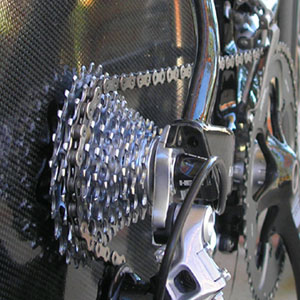
I chose to miter the seat mast before doing anything else to the frame or bike. Kuota makes a tool for this, which is a guide that gives you precise lines for the three cuts that constitute trimming this mast to size. Do you need this tool? I think I'd be fine without it, but having it made the job easy. The calcs were also easy. You just measure from the BB to the top of the saddle on your existing bike. Then mount your saddle on the Kueen K, push the seat post in all the way, and measure. Cut from the seat mast the difference between the Kueen K's uncut seat height and your seat height, and for good measure cut off an extra centimeter or so. It doesn't need to be exact. There are about 4 centimeters of adjustability in Kuota's seat mast once you've cut it.
I would install the fork next, but not miter the steerer unless you know with precision how much to miter. Or, you can do what I do. I never, ever have more than 20mm of spacers under my stem, so, I mitered the steerer for those 20mm. I'll likely miter it again later, but this allows me to get the thing ride-ready without having to disassemble the fork to cut the steerer after the bike is already assembled.
Usually, I start a build by installing the bottom bracket and the crankset. My advice: Install the brake calipers next, adjust the brake pads, install the fork and the handlebars, and the brake levers, and run the brake housing and cables before you do anything else. I say this because this bike's rear brake caliper mounts underneath the chain stays, and if you mount the crank before you run the brake cables you may find it hard to get around the chain rings if you've installed the crank. Just be patient and install the crank later, just before you're ready to mount the derailleurs and run the shift cables.

About the shifters. Wouldn't you know it, there's a tab on SRAM's front derailleur, part of the low gear adjustment assembly, that is specifically incompatible with the FD tab on the Kueen K. It's a clearance thing, the derailleur bangs on the tab and doesn't allow you enough throw for the derailleur to do its job. So, I took the FD tab off, let my bench grinder have at it, and the clearance problem was solved. If you do think a Kueen K is in your future, and SRAM is your choice, no worries: Kuota says it has an alternate derailleur tab that'll work fine with SRAM.
I steeled myself for a bitch of a time with this frame. Its weird brake set up, all those internal cables, I figured it would be just one of those days when a lot of patience and a little cussing stood between me and the conclusion of this build. I was very pleasantly surprised. All the cables routed like pie. In fact, the rear brake housing routes through the bike complete, without a split, from the brake lever all the way to the caliper. There is no split housing. I hate split housing.
The Tektro calipers that come on this bike, while easy enough to mount, are undeniably strange (the front mounts behind the fork, the rear behind the BB). The brake pads look off-center when all is mounted and routed. They are off-center. But, one caliper travels a greater distance than the other when engaged, by design, and what you have to look for is that neither caliper contacts the wheel before the other, or pushes the rim off to one side, while braking. There are a pair of 2mm Allen key screws, one on each side of each caliper, to feather the left-to-right adjustment. But, they didn't seem to me to do anything. Strange, yes, but, they seem to function fine.
There is plastic or Teflon lining through which the shift cables route, for both derailleurs. In both cases this must be trimmed where it exits the frame. One note on the SRAM rear derailleurs. There is a very elegant system of routing the cable that makes Shimano and Campagnolo seem a generation behind. I don't know whether the derailleur functions any better, but the engineering is impressive and it seems intuitively to be an improvement.
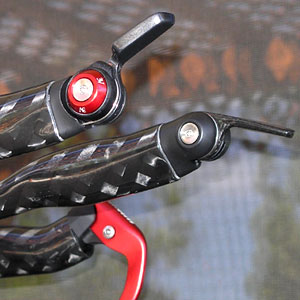
I first saw the Valdora aerobar at a small booth at Interbike. I've never been disappointed visiting the 10'x10' booths. You always find the best stuff there. Yes, Valdora makes some nice bicycles. But it was this bar that caught my eye. I've been waiting lo these months to get my hand on one, and thought it would be a nice thematic fit for this bike. Yes and no, as it turned out.
First, the yes. The bar is an ergonomic triple, as opposed to a home run. I've not yet met the ergonomic home run in an aerobar, and this one is close to as good as I've seen. All the contact points feel very good to the hands and arms. The comfort is there. How it will ride, how it will handle, I do not know and will not speculate about. We'll all know in a few days.
When you look at how the SRAM shifters match perfectly the contour of the Valdora's extension, and I mean perfectly match, you'd almost swear one was made to fit the other. Really, the whole build was like this. Hed's wheels, the bar, the frame, the group, all went together cosmetically and functionally, with two exceptions. The front derailleur is one such exception.
The other has to do with the fit of this bike. As noted, I like 'em long and low. What I did not reckon on was the compounding lowness of the Valdora SR1 aerobar. There is barely 2cm in elevation between the centerline of the handlebar clamp and the top of the armrest. This is the all-time low in low-profile bars. Previously, the distinction for the bar with the lowest profile armrest belonged to the Hed one-piece, with armrests 2.5cm above the centerline. It's one thing to like your head tubes low, but when you add a low profile aerobar to it, then you're looking at a construct that is certainly lower than the typical person would want.
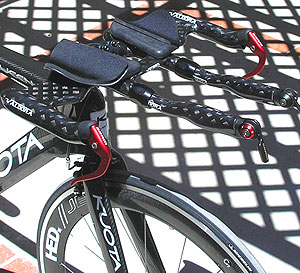
Let's consider my own case. I ride my tri bike with about 78.5cm of saddle height (BB to saddle top). My armrests sit 15cm below the top of my saddle. On the Cervelo P3C, I need no spacers under the stem. But, I'm riding with the factory headset top cap that is 2cm tall, and I'm riding a 3T Ventus, with 5cm of elevation between the centerline of the pursuit bar and the armrests. With the 3cm difference in armrest elevation between the Valdora and the 3T aerobar, and another 1cm difference between the Kueen K's 1cm top cap and that on the P3C, I had 4cm of elevation to find somewhere, that is to say, I need to raise the Valdora bars up 4cm. I'm certainly glad I left that 2cm of steerer on the fork!
That pair of 1cm headset spacers, plus a zero degree stem in place of the -17 degree stem, got me my elevation. But I must tell you that this bar is probably a better spec on a Cervelo P2C, or frames with taller head tubes, such as Cannondale's Slice and Scott's Plasma. Not that I'm complaining: 2cm of spacers isn't huge. In fact, let's take Jordan Rapp's position as an example. He rides with a slightly taller saddle than do I, by about 2cm. He rides with 19cm of drop, compared to my 15cm. Do the math, take the 2cm of spacers out from under the stem of this Kueen K I just built and, presto, the bike fits him perfectly.
But Jordan's an outlier, relative to the typical rider. He needs that drop to generate the hip angle that works best for him. Most people get that hip angle with a shallower drop. All this is to say that the Valdora bar is very, very nice, and the Kueen K is quite the bike. But, it's like a supercouple: Ben Affleck and Jennifer Lopez are great individually, but they may not represent the best example of a match.
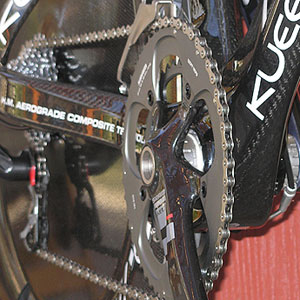
I've been eager to ride the Valdora bar, so I will do so on this bike. But, I've got a second 3T Ventus, and will eventually replace the Valdora with the Ventus and put the Valdora bar on another bike. There is another reason for this beside the fact that the Ventus, on the Kueen K, in this size, for me, represents a better set of spatial relationships between saddle and armrest. I'm going to settle to my own satisfaction what speed differences there are between these two frames. I suspect the P3C has superior aerodynamics, though I do not know definitively. I suspect the Kueen K is a stiffer bike in every plane, though I do not know whether that translates to speed. I've got a nice course for field trials set up for this, and I'll alternate time trials with the P3C and the Kueen K, using one set of wheels. Having the same bar on both bikes with take a bit of the noise out of the test.
A note about the wheels: I've finally decided to bite the bullet and bow to modern science. It seems that there is no good reason, excepting perhaps the time required to change a flat, to continue to cling to tubulars for racing. So, I've gotten myself what I think is a set of wheels that won't give up much if anything in the way of speed. I'm choosing Hed's factory covered Jet in place of a disc, because of my view about discs: that they're very aerodynamic, but that they don't hold the pavement as well through corners. Why this is I do not know, my best guess is that their stiffness lends to chatter and bounce, which occasionally dissociates the tire from the pavement and some of those occasions occur during turns. With this wheel I hope I can enjoy both aerodynamics and roadworthiness through corners. This bike as shown also has Michelin Pro Race 3 tires and latex tubes. It's topped with my trusty Profile Design TriStryke saddle, without which my hindquarters seem not to ride happily.


